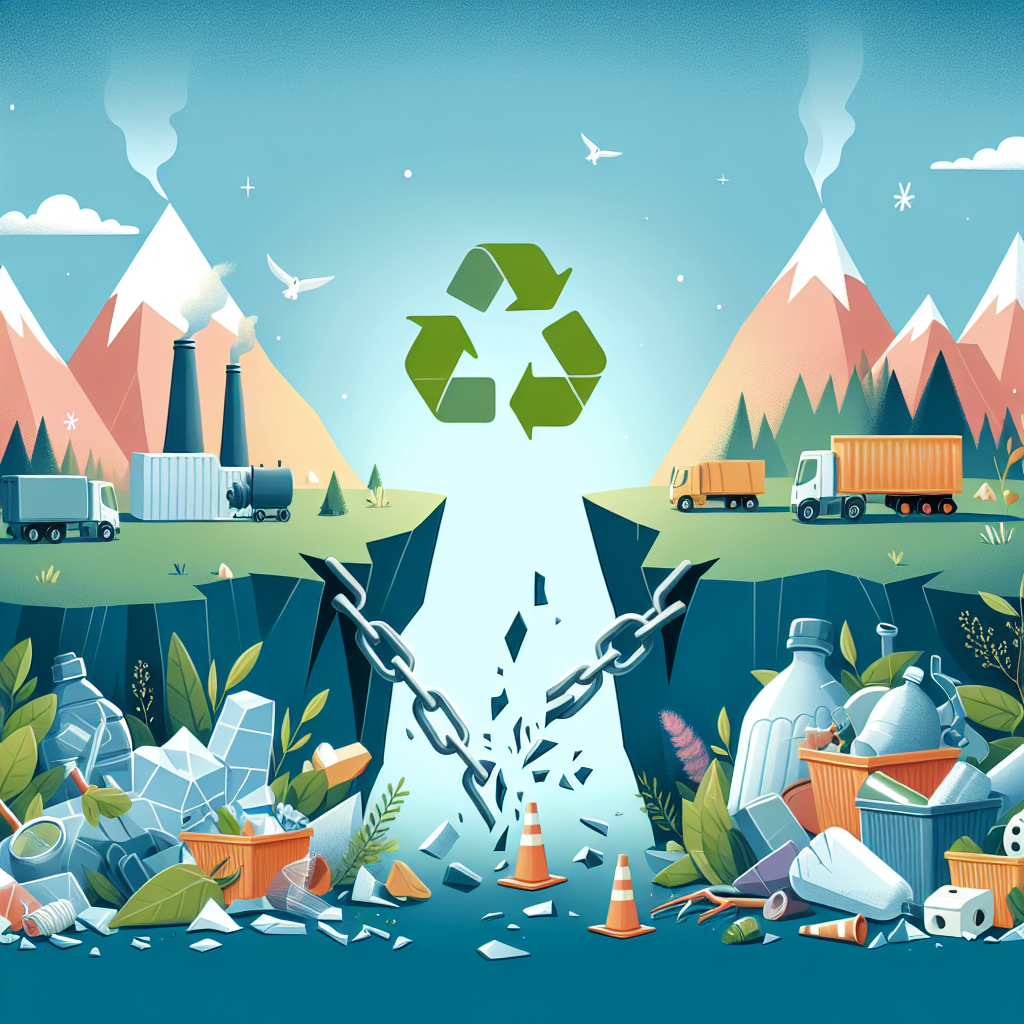Have you ever wondered if recycling is really worth all the effort? In this article, you will discover the truth behind some common recycling myths. From the belief that all plastics can be recycled to the misconception that recycling is just a waste of time, we will debunk these myths and shed light on the importance of recycling in preserving our planet. So, sit back, relax, and let’s dig into the world of recycling myths together.
Recycling Myths Debunked
Introduction
Recycling has become an important topic in our society as we strive to protect the environment and create a more sustainable future. However, there are several myths and misconceptions surrounding recycling that can discourage individuals from participating in this crucial practice. In this article, we will debunk some of the most common recycling myths, providing evidence and information to help you make informed decisions about recycling.
Myth: Recycling is not worth the effort
Many people believe that the effort required to recycle their waste is not worth the benefits it provides. However, this myth couldn’t be further from the truth. Recycling actually offers numerous benefits that make it a worthwhile endeavor.
Subheading 1: Recycling saves energy and resources
One of the main benefits of recycling is the energy and resources it saves. When we recycle materials such as paper, plastic, and aluminum, we can reduce the need for extracting and processing virgin materials. Manufacturing products from recycled materials requires less energy, water, and other resources compared to producing them from scratch. By recycling, you are directly contributing to the conservation of these valuable resources.
Subheading 2: Recycling reduces greenhouse gas emissions
Another important benefit of recycling is its contribution to reducing greenhouse gas emissions. The production of goods from virgin materials often involves burning fossil fuels, releasing carbon dioxide and other greenhouse gases into the atmosphere. On the other hand, recycling significantly reduces the amount of energy needed to produce new products, resulting in lower emissions. By recycling, you are helping to mitigate climate change and its detrimental effects.
Subheading 3: Recycling conserves landfill space
Landfills are filling up at an alarming rate, causing environmental and health risks. Recycling plays a crucial role in conserving landfill space. By diverting waste from landfills and recycling it, we can minimize the need for new landfills and reduce the environmental impact associated with waste disposal. Recycling not only helps preserve our natural landscapes but also protects us from potential pollution hazards.
Myth: Recycling is too complicated
Many people are deterred from recycling because they believe it is a complicated process. However, with a basic understanding of recycling symbols and guidelines, recycling can be much simpler than you might think.
Subheading 1: Understanding recycling symbols and guidelines
Recycling symbols can be found on the packaging of various products and indicate whether an item is recyclable or not. Familiarizing yourself with these symbols can help you make informed decisions about what can and cannot be recycled. Additionally, local recycling guidelines provided by your municipality will outline specific instructions on how to prepare and sort recyclables for collection. By taking the time to understand these symbols and guidelines, you can easily navigate the recycling process.
Subheading 2: Sorting recyclables properly
Another perceived complication with recycling is the sorting of recyclables. However, most recycling programs require only basic sorting, such as separating paper from plastic and glass. The key is to ensure that each type of recyclable is placed in the appropriate recycling bin or container. By dedicating a few extra seconds to sort your recyclables correctly, you can make a significant impact on reducing waste.

Subheading 3: Common misconceptions about recycling
There are several common misconceptions that can make recycling seem more complicated than it is. For example, some people believe that all the different types of materials need to be cleaned thoroughly before recycling. While it is good practice to rinse out containers to prevent contamination, excessive cleaning is not necessary. Understanding and debunking these misconceptions can help simplify the recycling process and encourage more individuals to participate.
Myth: Recycling doesn’t make a difference
Some individuals believe that their individual recycling efforts won’t make a significant impact on the environment. However, this myth fails to acknowledge both the individual and collective impact of recycling.
Subheading 1: The impact of individual recycling efforts
While it may be true that one person’s recycling efforts alone won’t solve the environmental challenges we face, it is the culmination of individual actions that leads to substantial change. Every time you recycle, you are saving energy, conserving resources, and reducing waste. When millions of individuals make conscious choices to recycle, the collective impact becomes significant.
Subheading 2: The collective impact of recycling
When we consider the collective impact of recycling, the numbers are staggering. According to a report by the Environmental Protection Agency (EPA), in 2018 alone, recycling and composting efforts in the United States prevented approximately 186 million metric tons of greenhouse gas emissions. Additionally, recycling conserves energy equivalent to the annual electricity use of nearly 30 million homes. These statistics demonstrate the power of recycling on a larger scale.
Subheading 3: Recycling’s role in the circular economy
Recycling is an integral part of the circular economy, which aims to minimize waste generation and maximize resource efficiency. By recycling materials, we can reintroduce them back into the production cycle, reducing the need for extracting new raw materials. This shift towards a circular economy allows us to create a more sustainable and resource-efficient society.
Myth: Recycling is always the most sustainable option
While recycling is an essential part of sustainable waste management, it is not always the most sustainable option in all circumstances. It is important to consider the principles of “reduce, reuse, recycle” and understand when recycling is the best choice.
Subheading 1: Examining the concept of reduce, reuse, recycle
The concept of “reduce, reuse, recycle” places emphasis on waste prevention rather than solely relying on recycling. In many cases, reducing and reusing should be the first steps taken to minimize waste and resource consumption. By reducing our consumption and reusing items whenever possible, we can reduce the need for recycling and conserve even more resources.
Subheading 2: The importance of reducing and reusing
Reducing and reusing help to address the root causes of waste generation and overconsumption. By opting for reusable items, such as water bottles and shopping bags, we can significantly reduce the amount of waste we produce. Additionally, choosing products with minimal packaging or buying in bulk can also contribute to waste reduction. By prioritizing these practices, we can create a more sustainable lifestyle.

Subheading 3: Knowing when recycling is the best option
While reducing and reusing should be our first choices, there are instances where recycling is the most sustainable option. For materials such as paper, glass, and aluminum, recycling is generally the best way to recover their value and conserve resources. It is essential to assess each item’s recyclability and determine the most appropriate disposal method based on its environmental impact.
Myth: All recycled materials are equal
Another common misconception is that all recycled materials are equal in terms of quality and value. However, the recycling process can vary depending on the material, and not all materials can be recycled infinitely.
Subheading 1: Understanding the different recycling processes
Different materials require different recycling processes. For example, paper and cardboard can be recycled into new paper products, while aluminum cans can be melted and reshaped. Understanding these processes helps us appreciate the value of recycling and the importance of properly sorting different materials.
Subheading 2: Challenges with recycling certain materials
Some materials pose challenges in the recycling process. For instance, plastics with different resin codes need to be separated and processed separately, making the recycling process more complex. Additionally, certain materials may have limitations on the number of times they can be recycled before their properties degrade. These challenges highlight the need for continued research and innovation in recycling technology.
Subheading 3: The importance of supporting recycling innovation
Supporting recycling innovation is crucial for improving the efficiency and effectiveness of the recycling process. Innovations such as advanced sorting technologies and new recycling methods can help overcome current limitations and expand the range of recyclable materials. By advocating for and supporting recycling innovation, we can create a more robust and sustainable recycling industry.
Myth: Recycling is too expensive
Many people believe that recycling is expensive and not financially viable. However, this myth overlooks the economic benefits and cost savings associated with recycling.
Subheading 1: The economic benefits of recycling
Recycling offers numerous economic benefits, including job creation and revenue generation. The recycling industry supports millions of jobs worldwide, from manufacturing facilities to collection and processing centers. Additionally, recycling can create new revenue streams through the sale of recycled materials, reducing the need for costly raw material extraction.
Subheading 2: Government and industry investments in recycling
Governments and industries recognize the importance of recycling and invest in its development and infrastructure. Funding for recycling programs, research, and education helps expand recycling capabilities and increase accessibility. By investing in recycling, governments and industries are not only promoting environmental sustainability but also stimulating economic growth.
Subheading 3: The long-term cost savings of recycling
While the initial costs of implementing recycling programs may exist, the long-term cost savings outweigh these expenses. Landfilling waste is an expensive and unsustainable practice, with costs increasing as landfill space becomes scarce. By diverting waste from landfills through recycling, communities can reduce their waste management costs, extend landfill lifespans, and avoid future environmental remediation expenses.
Myth: Recycling is just a feel-good activity
Some individuals believe that recycling is merely a feel-good activity that has little actual impact on the environment. However, recycling goes beyond personal satisfaction and actually offers numerous tangible benefits.
Subheading 1: The psychological benefits of recycling
Engaging in sustainable practices, such as recycling, can have positive psychological effects. Recycling allows individuals to feel a sense of contribution and control over their environmental impact. By actively participating in recycling, individuals can experience increased well-being and satisfaction, knowing they are making a positive difference.
Subheading 2: Encouraging sustainable behavior change
Recycling serves as a gateway to promote other sustainable behaviors. When individuals start recycling, they become more aware of their consumption patterns and waste generation. This awareness often leads to broader behavior changes, such as reducing plastic use, composting, or supporting local and sustainable products. Recycling, therefore, acts as a catalyst for sustainable lifestyle choices.
Subheading 3: The role of education and awareness
Education and awareness play a vital role in promoting recycling as an effective environmental practice. By providing accurate information and debunking recycling myths, we can empower individuals to make informed decisions. It is essential to educate children, adults, and communities about the importance and benefits of recycling, ensuring a sustainable future for generations to come.
Conclusion
In conclusion, recycling myths often misconstrue the true benefits and importance of recycling. By debunking these myths, we can encourage more individuals to participate in recycling and contribute to a more sustainable future. Recycling saves energy, reduces greenhouse gas emissions, and conserves landfill space. It may require a basic understanding of symbols and guidelines, but it is not as complicated as it may seem. Individual and collective recycling efforts can make a substantial impact, and recycling plays a vital role in the circular economy. While reducing and reusing should be prioritized, recycling is the best option for certain materials. All recycled materials are not equal, but supporting recycling innovation can overcome these challenges. Recycling is not expensive; instead, it offers economic benefits and long-term cost savings. Moreover, recycling has psychological benefits, promotes sustainable behavior change, and relies on education and awareness. By dispelling recycling myths, we can create a more informed and active recycling culture, leading to a cleaner and greener environment for all.

